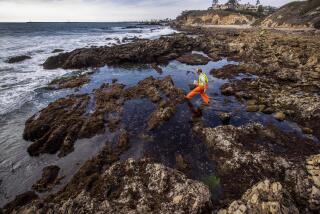Shell Oil’s Arctic drilling operations in limbo
SEATTLE — Six months after federal officials chastised Shell Oil for its faulty offshore drilling operations in the Arctic, the company has yet to explain what safeguards it has put in place or when it plans to resume exploring for oil in the vulnerable region.
Shell’s 2012 return to offshore Arctic exploration after a generation away was marred by high-profile problems, including hefty fines for polluting the air and a drilling rig that ran aground. The company canceled its 2013 drilling season, and its 2014 operations are in question.
The Interior Department is scheduled to unveil a set of tightened safeguards for offshore Arctic drilling before the end of the year, regulations whose need is underscored by Shell’s difficulties.
The rules are already having an effect on companies’ decisions about operating in the region next year. ConocoPhillips has announced that it will not drill in the Chukchi Sea in 2014 because of “the uncertainties of evolving federal regulatory requirements.”
Concerns remain about whether those federal standards will be stringent enough and whether drilling in America’s most promising new oil frontier even makes sense. The Beaufort and Chukchi seas have the potential to produce 500,000 barrels of oil each day, but they also nurture whales, walruses, seals and polar bears.
“If we don’t do this right, we are opening America’s Arctic to catastrophic industrial disasters,” said Jim Ayers, former director of the Exxon Valdez Oil Spill Trustee Council, who helped review the 2010 Deepwater Horizon oil spill in the Gulf of Mexico for the U.S. Coast Guard.
The Arctic is home to some of the most extreme weather conditions in the world. It is covered in ice for eight to nine months each year and cloaked in darkness for a third of that time. The closest Coast Guard base is nearly 1,000 miles away.
Struggling native Inuit communities depend on the area’s wildlife for survival. An oil spill in the remote region could rapidly escalate into disaster.
This week, the Pew Charitable Trusts released a lengthy analysis laying out what safeguards the group believes should be in place before any company drills in the region.
Offshore drilling should be seasonal, the report recommended, limited to a warm-weather window in which drilling rigs and spill-response systems could operate effectively before conditions deteriorated and ice impeded any potential cleanup.
Equipment should be “Arctic class,” able to withstand the region’s extreme conditions, the group said. Spill-response machinery and crews should be staged locally so that cleanup does not depend on equipment housed thousands of miles away.
“Right now, there are no regulations specific to the Arctic,” said Marilyn Heiman, director of the U.S. Arctic Program at Pew, noting that many federal drilling standards are the same whether a company is operating in the balmy Gulf of Mexico or the frigid Beaufort Sea.
“When the gulf spill happened [in 2010], they stopped cleaning up oil at 6-foot seas and when it was dark,” Heiman said. “In the Arctic, there are 20-foot seas, and, come November, it’s dark all day.”
Curtis Smith, a spokesman for Shell, declined to comment on the Pew recommendations and would not discuss his company’s progress on fulfilling federal demands that stemmed from the official review of its 2012 drilling season.
He also would not say whether Shell planned to resume oil exploration in the Arctic in 2014. Shell has spent nearly $5 billion preparing to drill in the Beaufort and Chukchi seas.
“Our future plans for offshore Alaska will depend on a number of factors,” Smith said in an email, “including the readiness of our rigs and our confidence that lessons learned from the 2012 operating season have been fully incorporated.”
The Interior Department’s March report on Shell’s 2012 drilling season concluded that the company’s “difficulties have raised serious questions regarding its ability to operate safely and responsibly in the challenging and unpredictable conditions” offshore in Alaska.
Among the demands that the government made before allowing Shell to drill again was that the company complete a third-party audit of its management systems.
An Interior Department spokesman said Tuesday that the agency had not received a completed audit and that Shell had not submitted an application to drill in 2014.
“Shell’s problems in 2012 are yet another example of what we already knew: Companies are not prepared to drill for oil in the Arctic Ocean,” said Michael LeVine, Pacific senior counsel for the environmental group Oceana.
“The federal government has an obligation as a steward of our ocean resources to take a step back and fundamentally rethink whether to allow offshore oil and gas activities in the Arctic Ocean and, if so, under what conditions,” he said. “Improved safety and operating standards are a good first step, but they are not sufficient.”
More to Read
Start your day right
Sign up for Essential California for news, features and recommendations from the L.A. Times and beyond in your inbox six days a week.
You may occasionally receive promotional content from the Los Angeles Times.







